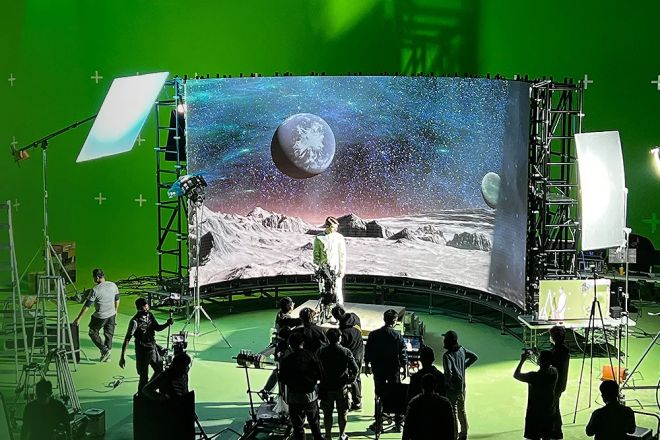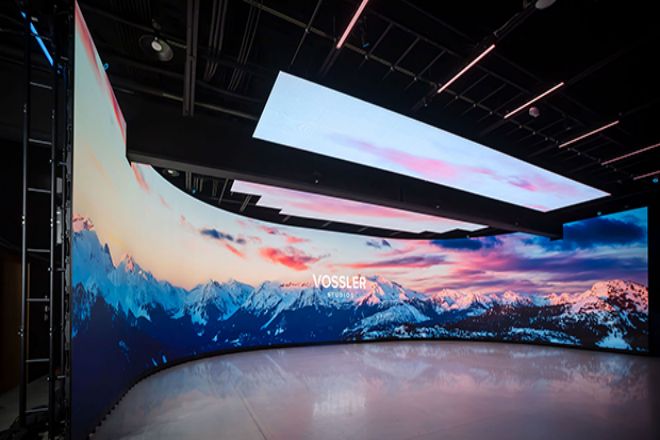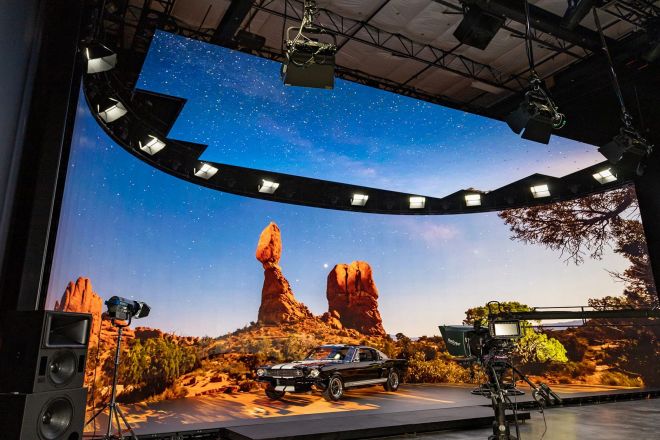Introduction

In the digital age of light and shadow, LED display screen technology has become a bridge connecting reality and virtuality.
With the rise of virtual visual technologies such as virtual shooting, VR, and AR, are you curious about how LED display screens will play a core role in this visual feast?
This article will take you to explore in depth and reveal why virtual vision is a key part of the future development of LED display screens.
1. What is the current status of the application of LED display screen technology in virtual vision?
1). LED display screens in virtual shooting
1.1). The role of LED screens as key display devices in virtual shooting
In virtual shooting, LED display screens play a vital role and become a key bridge connecting virtuality and reality.
It not only provides photographers and directors with an immersive, what-you-see-is-what-you-get shooting environment but also greatly reduces the use of green screens and reduces the cost and time of post-production.
LED display screens can present highly realistic virtual scenes through high resolution, high refresh rate, and high contrast, helping actors to better get into the play while also bringing a more shocking viewing experience to the audience.
1.2). How LED screens provide high-definition, realistic images and achieve real-time interaction and dynamic changes in scenes
- High definition and realism:
LED displays use high-resolution technology to ensure the clarity and details of the scene, avoiding pixel graininess when viewed at close range.
At the same time, high contrast makes the color of the image more vivid and the light and dark changes more delicate, thereby enhancing the realism of the picture.
- Real-time interaction and dynamic changes:
Through the combination with computer graphics technology, LED displays can achieve real-time interaction and dynamic changes in scenes.
Directors and photographers can observe the picture effects in real time during the shooting process, and adjust the shooting angle, lighting arrangement, etc. in time, thereby improving shooting efficiency.
In addition, LED screens can also be used as reflectors and softeners to provide photographers with better shooting effects.
1.3). Specific application cases and effects of LED screens in film and television production
- Film and television production:
In the production of movies and TV series, LED displays provide actors with realistic backgrounds and scenes.
For example, when shooting ancient court dramas, LED screens can present magnificent palaces and exquisite gardens, making the actors seem to be in a real ancient environment.
This shooting method not only improves the quality of the work, but also saves the cost and time of setting up real scenes.
- Advertising shooting:
In advertising shooting, LED display screens also play an important role.
It can provide a realistic product display environment, allowing consumers to understand the characteristics and advantages of the product more intuitively.
At the same time, LED screens can also achieve creative visual effects, making advertisements more attractive and impactful.
- Stage performances:
LED screens bring the audience the ultimate visual enjoyment.
By presenting various special effects and background pictures, LED screens make stage performances more colorful and enhance the audience’s immersion.
2). Integration of VR and LED display screens
2.1). Explore how the combination of virtual reality technology and LED display screens can enhance user experience.
The combination of virtual reality technology and LED display screens brings users an unprecedented sense of immersion. Through high-resolution and high-brightness LED display screens, VR devices can present a clearer and more realistic virtual environment.
After users put on VR helmets, they seem to be in a brand new world; whether it is the long river of history, the mysterious universe, or the fantasy world, they can get an immersive experience.
2.2). Analyze the application of high-resolution and high-brightness LED screens in VR devices and how they enhance the immersion of virtual environments.
- High resolution:
High-resolution LED display screens can ensure that the images in VR devices are clear and delicate, avoiding the impact of pixel graininess on immersion.
This makes it more natural and comfortable for users to watch virtual environments.
- High brightness:
High-brightness LED displays can maintain image clarity and color saturation under various lighting conditions. In VR devices, high-brightness displays can simulate light changes in real environments and enhance user immersion.
2.3). Mentioning the potential and challenges of LED displays in VR helmets
- Potential:
With the continuous advancement of technology, LED displays in VR helmets will develop towards higher resolution, higher brightness, and wider viewing angles.
This will further enhance the user’s sense of immersion and make the VR experience more realistic and natural.
- Challenges:
However, the development of LED displays in VR helmets also faces some challenges. First, the cost and weight of the equipment need to be further optimized to improve the user’s comfort and portability.
Secondly, how to reduce light pollution and glare is also a problem that needs to be solved. In addition, as users’ requirements for VR experience continue to increase, how to continuously improve the performance of the display to meet these requirements is also a continuous challenge.
2. The unique advantages of LED display screens compared to other virtual vision devices

1). Technological innovation and upgrading
1.1). Continuous breakthroughs in core technologies
- Resolution improvement:
The growing demand for virtual vision has driven the continuous improvement of the resolution of LED display screens.
Today, LED display screens can achieve 4K, 8K and even higher resolution displays, making images clearer and more realistic, meeting the high requirements of virtual vision for details and realism.
- Color reproduction and brightness optimization:
LED display screens have also made continuous breakthroughs in color reproduction and brightness. Its high color reproduction ability can accurately present the rich colors in virtual scenes, while high brightness ensures a clear display effect under different lighting conditions.
1.2). Development of new display technology
With the advancement of material science and display technology, flexible LED display screens have emerged. This type of display screen can be bent, folded, or even curled, providing more forms and possibilities for virtual vision.
For example, in VR helmets, flexible LED display screens can better fit the user’s facial contours and improve wearing comfort.
- Foldable display:
Foldable display is another new display technology that combines the advantages of flexible display and mechanical structure, and can achieve portability while maintaining large screen display.
This display has broad application prospects in virtual visual devices, especially in mobile devices and wearable devices.
2). Market expansion and demand growth
2.1). Demand growth trend
With the rapid development of technologies such as virtual reality (VR) and augmented reality (AR), the demand for LED display in the virtual visual field is growing.
These technologies require high-resolution, high-color reproduction and high-brightness display to present realistic virtual environments, and LED display just meets these needs.
2.2). Wide application prospects
LED display plays an important role in film and television production, providing directors and photographers with a what-you-see-is-what-you-get shooting environment, reducing post-production costs and time.
In the field of games, LED displays provide players with a more immersive gaming experience. Through high-resolution and high-brightness displays, players can see the details and changes in the game scenes more clearly.
In the advertising industry, the diversity and interactivity of LED displays make them an effective tool to attract the audience’s attention. Advertisers can use the creative display methods of LED display screens to improve the attractiveness and communication effect of advertisements.
In the field of education, LED display screens can be used in scenarios such as teaching demonstrations and virtual experiments to help students better understand knowledge and improve their learning interests.
3). Coordinated development of the industrial chain
3.1). The maturity and perfection of technology and the industrial chain
The coordinated development of virtual vision technology and LED display technology has promoted the maturity and perfection of the entire industrial chain.
The joint efforts of hardware manufacturers, software developers, and content producers have promoted the application and development of LED display screens in the field of virtual vision.
3.2). Application of AI technology
- The introduction of AIGC technology:
AIGC (Artificial Intelligence Generated Content) technology provides more possibilities for the application of LED display screens in virtual vision. The content generated by AI technology can be combined with the display effect of LED display screens to create a more vivid and realistic virtual environment.
- Intelligent management:
AI technology can also be used for intelligent management of LED display screens. For example, the brightness, color, and contrast of the display screen are automatically adjusted and optimized through AI algorithms to adapt to different virtual vision needs and environmental conditions. This intelligent management method improves the use efficiency and user experience of the display screen.
3. The value that can be brought by using LED display screens in virtual vision technology
1). Technological innovation and visual experience improvement
- High resolution and color reproduction:
LED display screens have the characteristics of high resolution and high color reproduction, which can present delicate and realistic images, making virtual scenes more vivid and realistic.
This technical advantage greatly enhances the audience’s visual experience, making them feel as if they are in a real virtual environment.
- High brightness and adjustability:
The brightness of the LED display screen can be adjusted according to the shooting or display requirements to ensure the best visual effect in different lighting environments.
This adjustability provides greater flexibility and freedom for the application of virtual visual technology.
- Real-time interaction and dynamic changes:
Through the combination of computer graphics technology, LED display screens can achieve real-time interaction and dynamic changes in scenes.
This function enables virtual visual technology to respond more flexibly to various shooting or display requirements and also brings a more immersive experience to the audience.
2). Cost efficiency optimization
- Reduced production costs:
Compared with traditional shooting methods, LED display screens can reduce the cost of renting real scenes, props, etc., in virtual shooting. At the same time, the virtual scenes created by LED display screens can be reused, avoiding the cost of scene construction and dismantling in traditional shooting.
- Improve production efficiency:
The real-time preview function of the LED display allows directors and photographers to quickly adjust the picture effect during the shooting process, reducing the time and cost of post-production. This efficient workflow helps to improve the efficiency of the entire production process.
3). Market expansion and application prospects
- Wide application fields:
The application of LED display screens in virtual visual technology is not limited to the field of film and television production but is also widely used in games, advertising, education, and other industries. This wide application prospect brings huge development potential to the LED display screen market.
- Promote industrial upgrading:
With the continuous development of virtual visual technology, LED display screens, as one of the key display devices, will continue to promote the upgrading and transformation of related industries.
For example, in the game industry, the application of LED display screens will enhance the immersion and experience quality of game players; in the advertising industry, the diversity and interactivity of LED display screens will attract more advertisers.
4. Challenges and coping strategies that may be faced

Although the use of LED display screens in virtual visual technology brings many advantages, it also faces some technical challenges and market challenges. The following is an analysis of these challenges and corresponding coping strategies.
1). Balance between high resolution, high brightness, and low power consumption
In virtual visual applications, LED display screens need to meet the requirements of high resolution, high brightness, and low power consumption.
However, high resolution and high brightness often mean higher energy consumption. How to reduce energy consumption while ensuring the display effect is a major technical challenge currently faced.
- Response strategy:
Strengthen technology research and development to promote innovation in display technology.
For example, by optimizing the LED chip structure, improving the driving circuit and heat dissipation design, the energy efficiency ratio of the display can be improved. At the same time, new display materials and technologies, such as Micro LED, can be explored to achieve higher resolution and lower power consumption.
2). Durability and cost issues of flexible screens
Although flexible LED displays have unique advantages such as bendability and foldability, their durability and cost issues are still key factors restricting their widespread application. Flexible screens are prone to damage during repeated bending and have high production costs.
- Response strategy:
Strengthen research on material science and manufacturing processes to improve the durability and reliability of flexible screens. At the same time, production costs can be reduced through large-scale production and process optimization.
In addition, the application of flexible screens in specific fields, such as wearable devices, virtual reality devices, etc., can be explored to give play to their unique advantages.
Conclusion
In summary, virtual vision is undoubtedly one of the important sectors for the future development of LED displays. With the continuous advancement of technology and the continuous growth of market demand, the application of LED display screens in the field of virtual vision will become more extensive and in-depth.
From virtual shooting in film and television production to immersive experiences in-game entertainment to virtual simulation in education and training, LED display screens, with their unique advantages, provide strong support for the realization of virtual vision technology.
Finally, if you want to know more about LED display screens, please get in touch with us.
